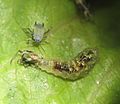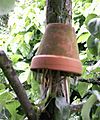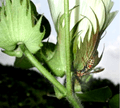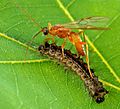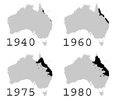Biological control facts for kids
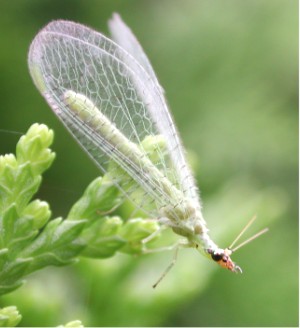
Biological control, also called biological pest control, is a way to manage pests using their natural enemies. Pests are living things like insects, weeds, or diseases that harm crops, animals, or people. This method is important because pests can become resistant to chemical sprays (pesticides).
Natural enemies of insect pests include predators, parasitoids, and pathogens. For weeds, natural enemies can be herbivores (animals that eat plants) or plant diseases.
- Predators are animals that hunt and eat other animals. Examples are birds, lady beetles, and lacewings. They are free-living and eat many pests during their lives.
- Parasitoids are special insects whose young (larvae) grow on or inside a single insect host. They eventually kill the host. Many types of wasps and some flies are parasitoids. They usually only attack one or a few specific pest types.
- Pathogens are tiny living things that cause diseases. These include bacteria, fungi, and viruses. They make their host sick or kill it. Pathogens are also quite specific to the pests they attack.
Contents
How Does Biological Control Work?
There are three main ways to use biological control: conservation, classical biological control, and augmentation.
Conservation: Protecting Natural Helpers
Conservation means protecting and encouraging the natural enemies that are already in an area. This often involves avoiding pesticides that might harm these helpful creatures. Farmers can also plant certain plants that attract or provide shelter for natural enemies.
For example, in China, farmers have used a plant called mosquito fern with rice crops for over a thousand years. This fern helps rice grow because it hosts a special type of cyanobacteria. This bacteria takes nitrogen from the air, which acts like a natural fertilizer for the rice. The fern also helps by blocking sunlight from other weeds, but not the taller rice plants.
Classical Biological Control: Introducing New Helpers
Classical biological control involves bringing natural enemies from one area to a new place where they don't naturally live. This method works very well when a pest is an invasive species. An invasive species is a plant or animal that has moved to a new area and is causing harm. Since it's away from its natural enemies, it can multiply very quickly.
By introducing one or two of its natural enemies from its original home, the pest population can be controlled. For instance, the Larinus planus beetle was brought in to help control the Canada thistle, a harmful weed. Once introduced, these new helpers live and reproduce in the new habitat, becoming a natural part of the ecosystem.
Augmentation: Adding More Helpers
Augmentation means releasing a large number of natural enemies at specific times. These natural enemies might already be present in the area, but not in enough numbers to control a big pest problem. Farmers can buy these helpful insects or organisms from special suppliers.
The goal is to release so many natural enemies that they can overwhelm the pest population at a critical moment. This helps to quickly reduce the number of pests when they are causing the most damage.
An Early Example of Biological Control
One of the earliest known examples of biological control comes from China. A text from 304 AD, called Records of the plants and trees of the southern regions, describes how mandarin orange trees were protected. Large reddish-yellow citrus ants were used to attack and kill insect pests on the orange trees.
This citrus ant (Oecophylla smaragdina) was "rediscovered" in the 20th century. Today, it is still used in China to protect orange groves, showing how effective this natural method can be over a very long time.
Images for kids
-
A parasitoid wasp (Cotesia congregata) with its cocoons on a tobacco hornworm (green background). This is an example of a hymenopteran biological control agent.
-
Cactoblastis cactorum larvae eating Opuntia prickly pear cacti.
-
Rodolia cardinalis, the vedalia beetle, was brought from Australia to California in the 1800s. It successfully controlled the cottony cushion scale pest.
-
The invasive plant Alternanthera philoxeroides (alligator weed) was controlled in Florida (U.S.) by introducing the alligator weed flea beetle.
-
Hippodamia convergens, the convergent lady beetle, is often sold to help control aphids.
-
An upside-down flowerpot filled with straw can attract earwigs, which eat some pests.
-
A Polistes wasp searching for bollworms or other caterpillars on a cotton plant.
-
The parasitoid wasp Aleiodes indiscretus attacking a spongy moth caterpillar, a serious forest pest.
-
Encarsia formosa, a tiny wasp, was one of the first biological control agents developed. It is widely used in greenhouses to control whiteflies.
-
The Cane toad was brought to Australia in 1935. This map shows its spread from 1940 to 1980. It was not effective as a control agent and has continued to spread since 1980.
See also
 In Spanish: Control biológico para niños
In Spanish: Control biológico para niños


